Most of us associate ladybugs with the iconic image of a bright red dome-shaped critter with black spots. The famous stereotype of a cutesy beetle, however, is only the tip of a very colorful iceberg.
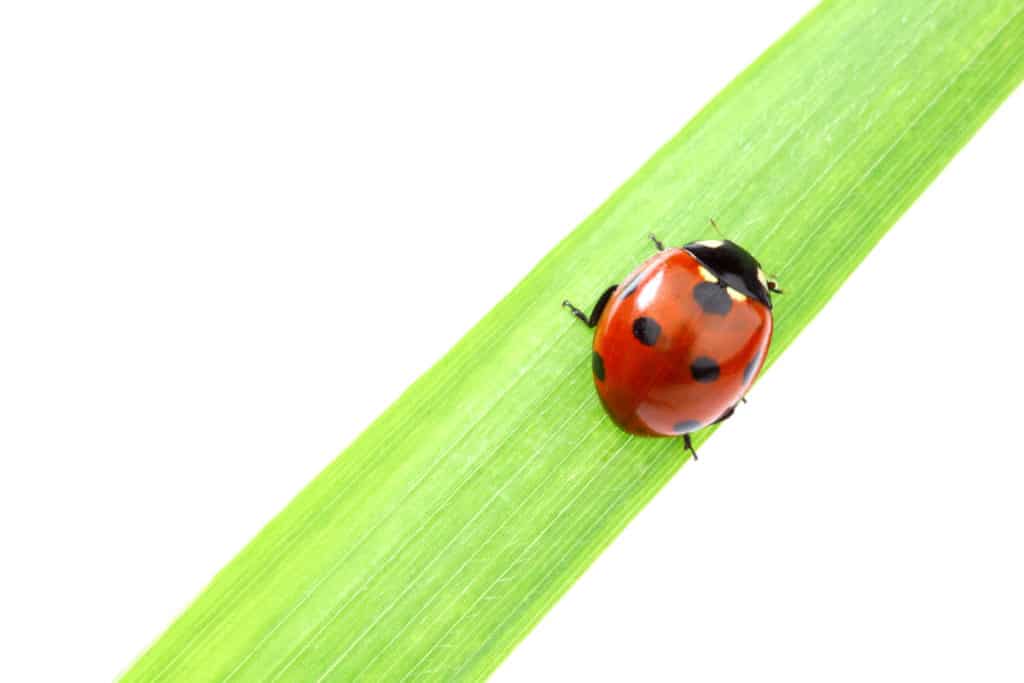
There are over 5,000 different species of ladybugs and each comes with its own unique physical characteristics. The variability of ladybugs is seen in the diversity of colors they represent; Black, Brown, Steelblue, Red, Pink, Orange, Yellow, and White/Grey.
We decided to go through each color in turn, identifying a few species of that color, where they are from, and where they can be found.
Their dietary preferences. Although almost all ladybugs are omnivorous, they can be categorized into groups according to their essential food source. There are three categories; predation, plant feeding, and fungus feeding.
Their toxicity levels. In nature conspicuous colors mean poisonous. Being aposematic, with coloration that honestly signals their toxicity levels, ladybugs are no exception to the color rule. However, ladybugs are not toxic to humans, they are only toxic enough to taste bad to predators.
This is a list of the different colors of ladybugs we are going to be investigating in this article:
- Black Ladybugs
- Brown Ladybugs
- Blue Ladybugs
- Red Ladybugs
- Pink Ladybugs
- Orange Ladybugs
- Yellow Ladybugs
- White/Grey/Beige Ladybugs
1. Black Ladybugs
Several species of ladybug display multiple color and pattern variations-an biological occurrence known as polymorphism. Many of these variations (or morphs) include a color reversal where black becomes predominant. These darker variations are called melanic forms or morphs.
The Asian ladybug, the Ash grey ladybug, the Cardinal ladybug, the Two-spotted ladybug, the Fourteen spotted ladybug, and hundreds of other species have their melanic forms. These forms arise as a response to genetic and environmental factors.
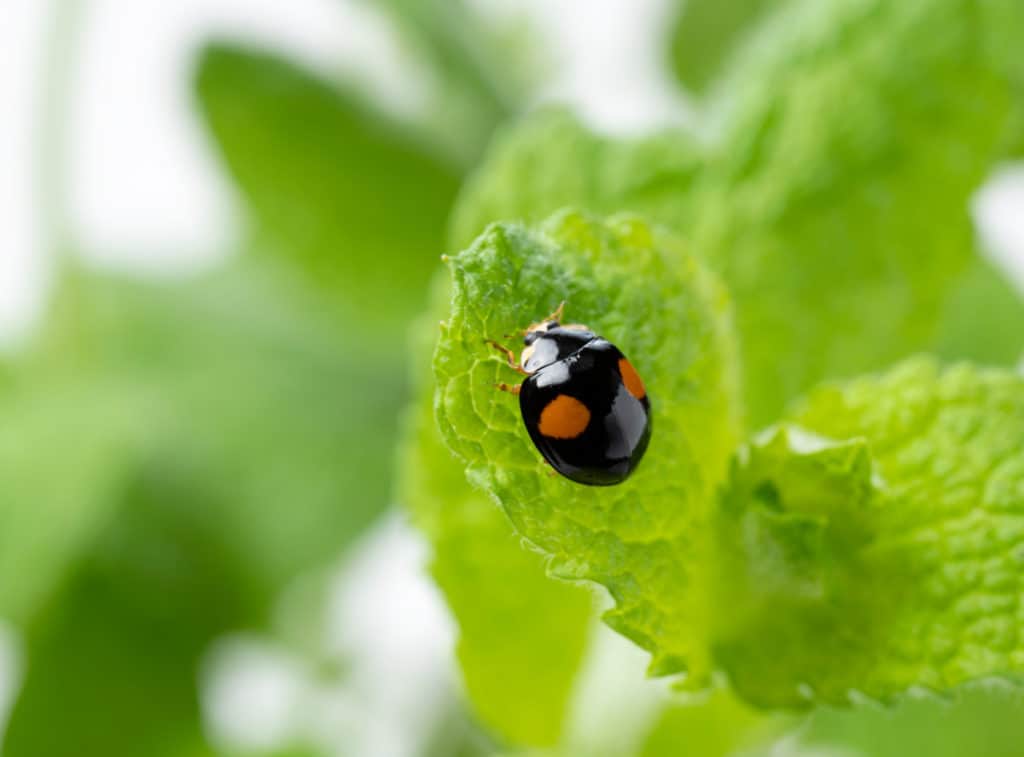
There are several genera of ladybug that consist of species with predominantly black shells as their typical morph. These genera include (but are not limited to) the Rhyzobius, the Chilocorus, Orcus, and the Brachiacantha.
Rhyzobius Ladybugs
Rhyzobius is a genus of ladybug whose members mostly originated in Australia or New Zealand and are predominantly black to dark brown in color. Several of these species can be found in Asia, the Americas, and Europe including the Forestier’s ladybug (Rhyzobius forestieri), the Gumtree scale ladybug (Rhyzobius ventralis), and the Purple scale predator (Rhyzobius lophanthae)
All of these species have black shells with a furry layer of small white hairs. The hairs give them a silvery hue. Though frequently confused as one species there are a few differences in these ladybugs’ appearance.
The Forestier ladybug is slightly smaller and more rounded than the Gumtree and the Purple scale predator has a brown head and legs.
Orcus Ladybugs
The most well-known species within the genus Orcus is the Orange spotted ladybug (Orcus australasiae often confused with the Orcus bilunulatus).
There are about twenty-one species belonging to the genus Orcus. All originating in Australia or Papua New Guinea. Today, these ladybugs can be found throughout Oceania and Asia.
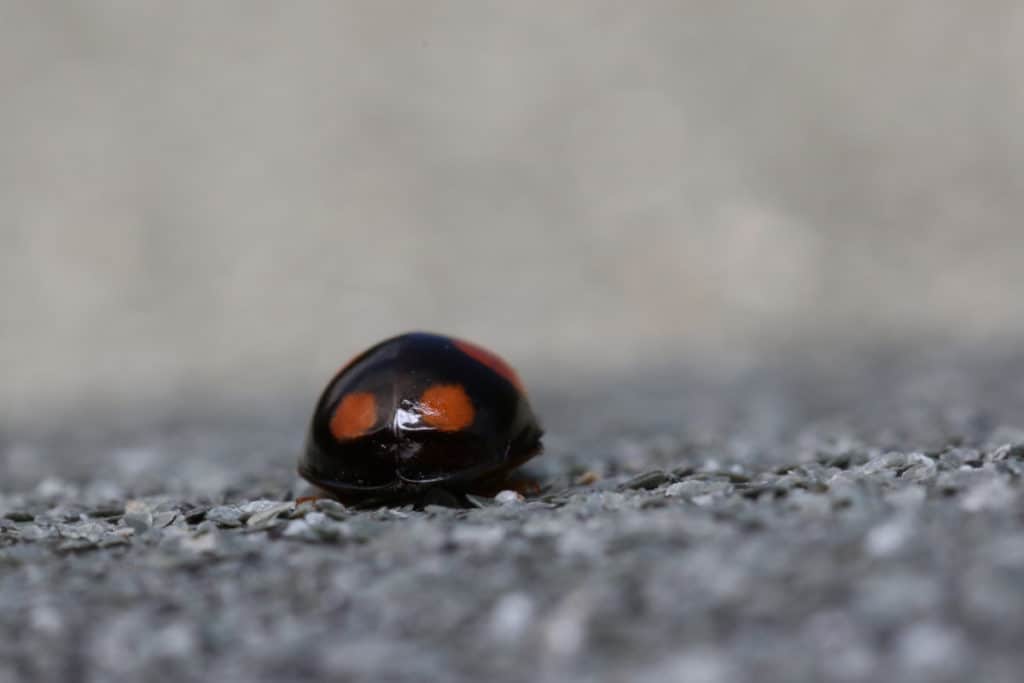
They typically have rounded convex black shells. Some species such as the Orange spotted ladybug, have spots ranging in color through yellow, orange, and red. While others are solid black with a metallic reflection that can be tinged red, blue, or green.
Brachiacantha Ladybugs
There are several different species of ladybugs who have earned the moniker ‘Orange spotted’. The name applies to the majority of the genus Brachiacantha which includes over twenty species of ladybugs.
These beetles are rounded or oval with a convex shell. They are black with varying amounts of yellow to orange-colored spots. Their most notable feature is their uniquely large iridescent blue eyes.
Despite their similarities with the genus Orcus, these ladybugs are found on the opposite side of the world being native to North, South, and Central America and Mexico.
Black colored ladybugs– Dietary Preference
Though black-colored ladybugs are from different places and vary in dramatic ways, they are primarily predacious, feeding on a variety of scale insects, spider mites, and aphids.
Within these select ladybug species, scale insects seem to be the favored food. The Rhyzobius lophanthae is well known for being the natural enemy of the Diaspididae scales. While the rest of its relatives divided up soft scale insects in a type of ‘prey specialization’.
Interestingly, the Brachiacantha larvae are fed domesticated scale insects inside ants’ nests.
Black colored ladybugs –Toxicity
When it comes to black-colored ladybugs and their toxicity there are various studies with conflicting results.
In one often referenced study, the Pine ladybug, another black ladybug with red spots, was found to have the second-highest level of toxicity out of five differently-colored species.
Another study looked at the different morphs of the Asian ladybug (Harmonia axyridis). They found that ladybugs who had more red (less black) had greater amounts of alkaloid. This correlation is particularly true for female ladybugs.
If you are interested in the whole story on whether ladybugs are poisonous then check this whole article we have written dedicated to the topic. Are Ladybugs Poisonous?
2. Brown Ladybugs
Out of all of the colors, brown is usually underrated, the same can be said for brown ladybugs. Though there are several surprisingly beautiful brown colored ladybugs.
Once again, brown morphs can be found in several ladybug species, most commonly the Multicolored Asian ladybug.
A few of the species that have brown as a typical form are; the Larch ladybug (Aphidecta obliterata), the Striped ladybug (Myzia oblongoguttata), and the Cream spotted ladybug (Calvia quatuordecimguttata).
The Larch Ladybug
The origins of the Larch ladybug are unclear. Today, the largest population of Larch ladybugs resides in the UK.
The Larch ladybug is a typical beetle-looking ladybug, with a boxy oblong shell. It is a rustic tan color with a beige head, and its pattern varies from splotchy brown spots to nothing.
The Striped Ladybug
While there are several ladybugs called the Striped ladybug, the one we are talking about goes by the Latin name Myzia oblongoguttata. Though its origins are unclear, it is commonly found in the U.K., Europe, and parts of Asia.
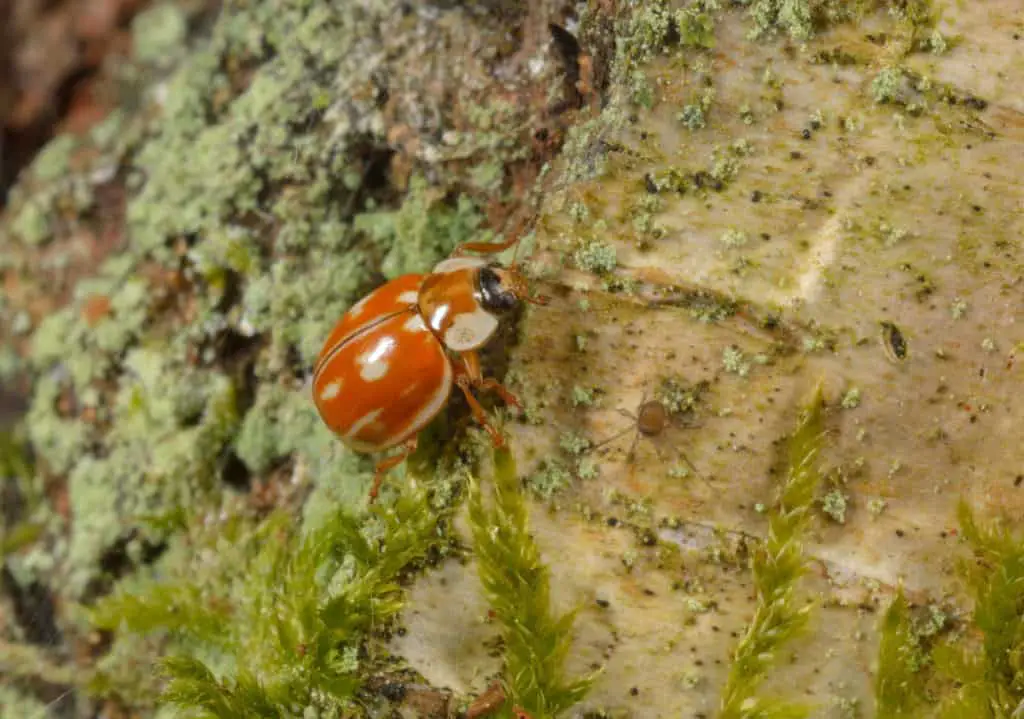
It is one of the most interesting looking ladybugs. It is colored a rich chestnut with cream-colored brush-like streaks running vertically down its shell. It is also slightly rectangular and its head is brown and white.
The Cream Spotted Ladybug
Native to Asia, North America, and northern Europe (though it can be found throughout the world) the Cream spotted ladybug is also polymorphic.
A few of the most common variations of this ladybug are; black with white spots, orange with black spots, and of course brown with cream-colored spots.
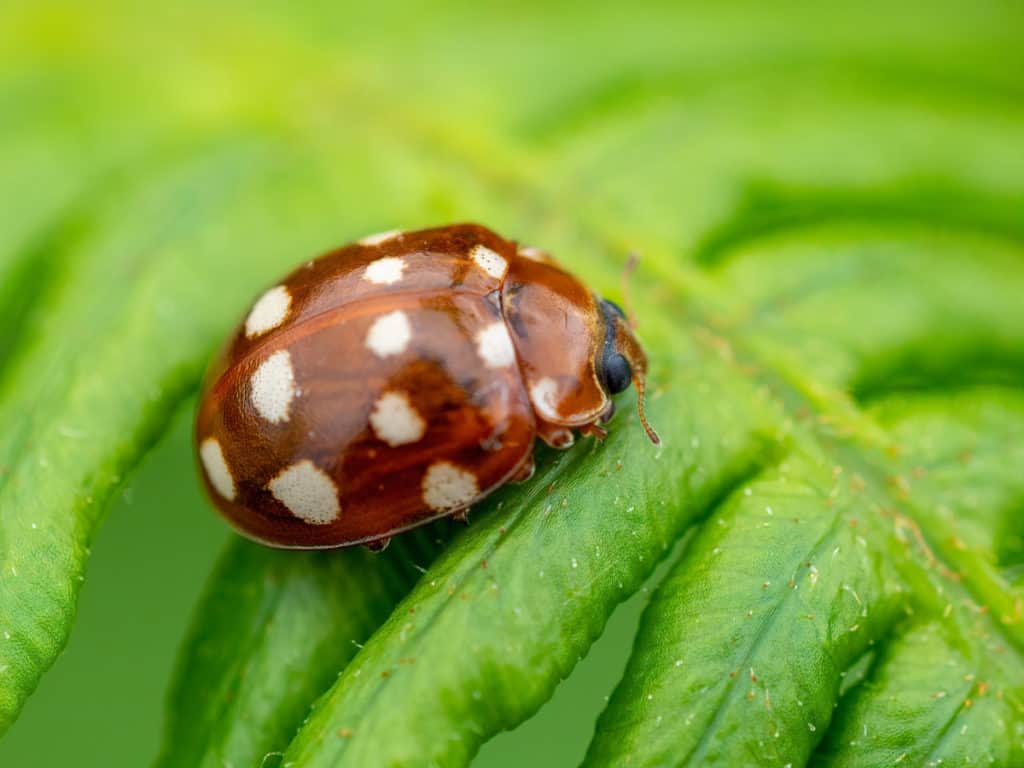
This brown version has fourteen spots, to be exact. Its shell and head are oak-brown and it has a slightly oblong shape.
Dietary Preferences
All of these ladybugs are predaceous. They usually inhabit trees and bushes where they can hunt down and feed on aphids.
Toxicity
According to a research article found in Front. Ecol. Evol., brown is not a signaling color, making it highly unlikely that these ladybugs or any brown forms or species are particularly toxic.
A study in Nature adds to this reasoning by demonstrating that the Larch ladybug had the lowest levels of toxicity out of five different colored ladybug species. These brown-colored ladybugs have to rely on camouflage and hiding to avoid predators.
3.Blue Ladybug
There are thousands of pictures of blue ladybugs online. Most of these pictures show the ladybug as a powder-blue to a sapphire-colored shell with large black spots. While these representations are nothing but photoshopped click baits, a blue ladybug does exist.
Called the Steel blue ladybug (Halmus chalybeus) this unique beetle is native to Australia but it can be found all around the world.
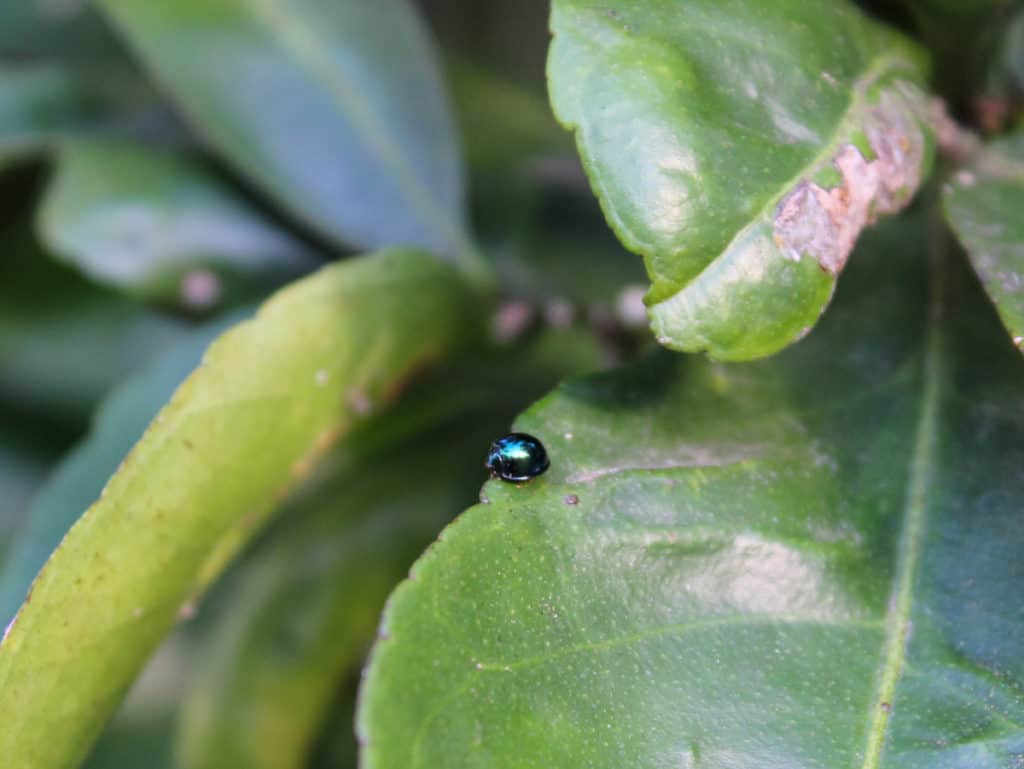
Like the classic ladybug, the Steelblue ladybug has a rounded convex body. Its shell is dark (almost black) with an iridescent shine. This iridescent color ranges from steely blue to turquoise.
Dietary Preference
The Steel blue ladybug is predacious, mostly feeding on small insects. Though adults will also eat nectar and other plant products.
Toxicity
There is no information on the Steel blue ladybug’s toxicity. As was pointed out in a paper in Behavior Ecology, there is a dearth of information on color signaling with alternative forms of coloration, such as a metallic reflection.
4. Red Ladybugs
Red is by far the most common or at least most well-known ladybug color. But even red ladybugs come in a variety. Some of them have twenty spots, while others have stripes or no markings at all. Some of them are round and others are oblong.
The Eyed ladybug (Anatis ocellata) and the Seven-spotted ladybug (Coccinella septempunctata) are a few examples of different red ladybug variations.
The Eyed Ladybug
Though its origins are unclear, this ladybug can be found throughout North America, the UK, and Europe.
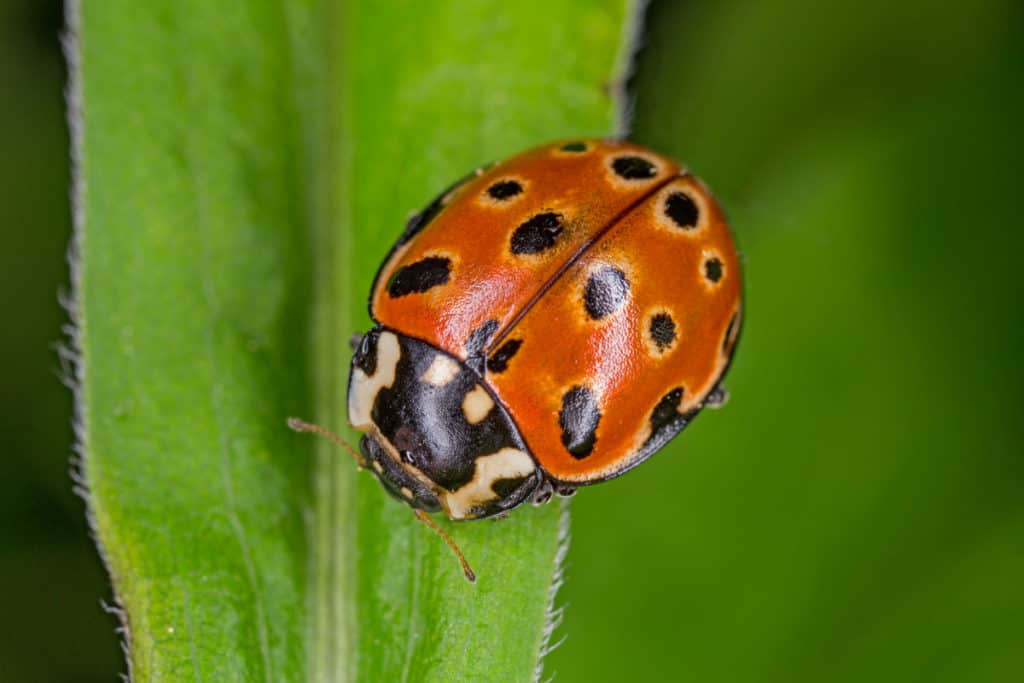
This ladybug has a distinctive pattern on its rounded helmet-like shell. While the shell is colored a rusty red, its black spots are encircled by pale rings. Its head is black and white, and it is the largest ladybug in the UK.
A variation of the Anatis ocellata was recently discovered in Slovakia. This variation has interconnected black strips running vertically down the ladybug’s shell.
The Seven-Spotted Ladybug
Although the Seven-spotted ladybug is culturally popular in North America, it originated in Asia and Europe and is classified as an invasive species in the US.
These ladybugs are easily identified by their seven clear black spots and their bright red shells. They have a convex shape and are slightly larger than other ladybugs.
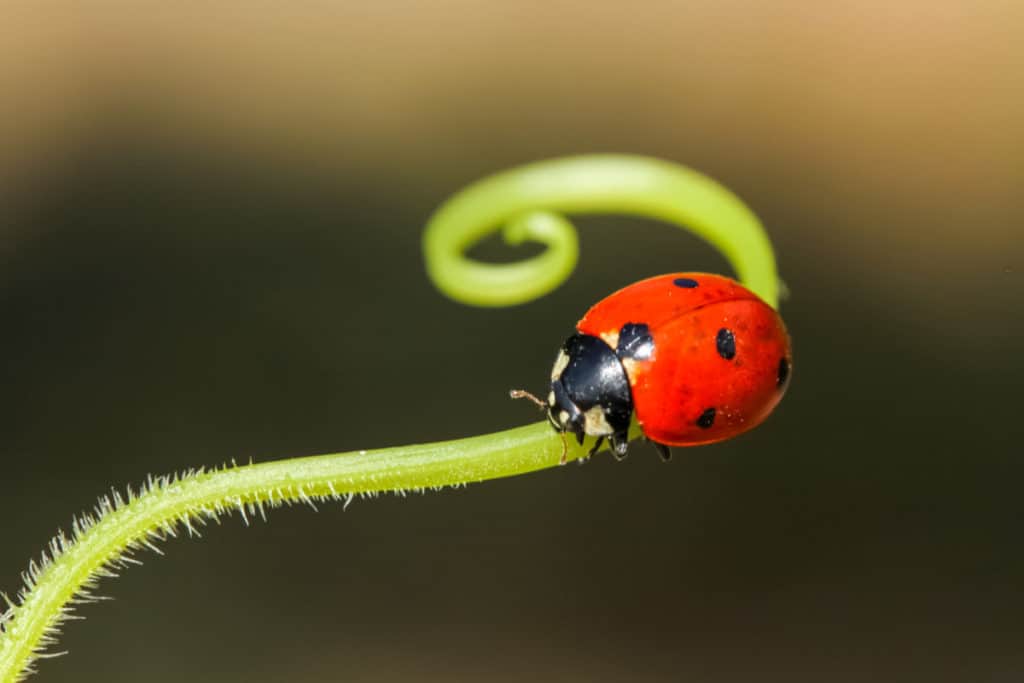
Their heads are black and white and they have two white spots on their shell right above their heads.
Dietary Preferences
Both of these ladybug species are predacious. The Eyed and Seven-spotted ladybug primarily eat aphids.
The red coloration of these ladybugs is caused by carotenoids. Carotenoids are produced by gut microbes. In the case of red and orange ladybugs, their diet directly correlates with their coloration, particularly in females.
Toxicity
Being highly conspicuous, red ladybugs tend to be more toxic. In a study measuring the toxicity of five differently-colored species. The red Two-spotted ladybug was the second most toxic.
Wondering if something this cute would bite? We have done the research, if you are interested in finding out if ladybugs can bite check out this article we have written called, Do Ladybugs Bite? They’re So Cute, Surely Not!
5. Pink Ladybug
There is one ladybug that can truly be called pink. It is commonly known as the Pink spotted ladybug or the Twelve-spotted ladybug. Its scientific name is Coleomegilla maculata, and it comes in three variations.
Between the three variants, these pink ladybugs can be found throughout the Eastern United States, across the U.S.’s southern border, and all over Florida.
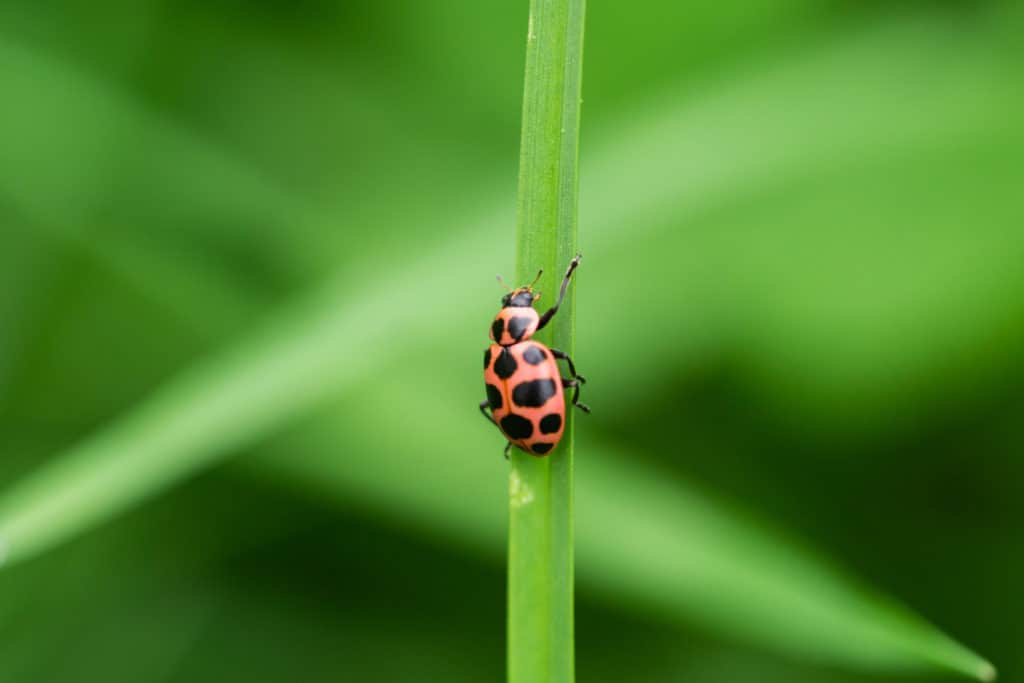
All of the pink spotted ladybugs have an oblong-shaped body, twelve black spots, and their color ranges from a rosy pink to a pinkish-red.
Dietary Preferences
Deviating from the typical carnivorous lifestyle many of their fellow ladybugs enjoy, the Pink spotted ladybug’s diet is 50% plant pollen. Its essential food source is zoological and plant-based.
Toxicity
There is no information about the Pink spotted ladybug’s toxicity. However, one study did suggest that because pink is a less saturated color than red it would indicate lower levels of toxicity.
6. Orange Ladybugs
When people mention orange ladybugs they are often talking about the Multicolored Asian ladybug (Harmonia axyridis). With good reason, the Asian ladybug is often sighted as an invasive species, driving other native ladybugs out and invading homes.
However, several other ladybug species are orange as well including the Orange ladybug, the Mexican bean beetle, the Squash beetle, and the Hadda beetle.
The Orange Ladybug
The Orange ladybug, otherwise known as Halyzia sedecimguttata, is commonly found in England and Wales.
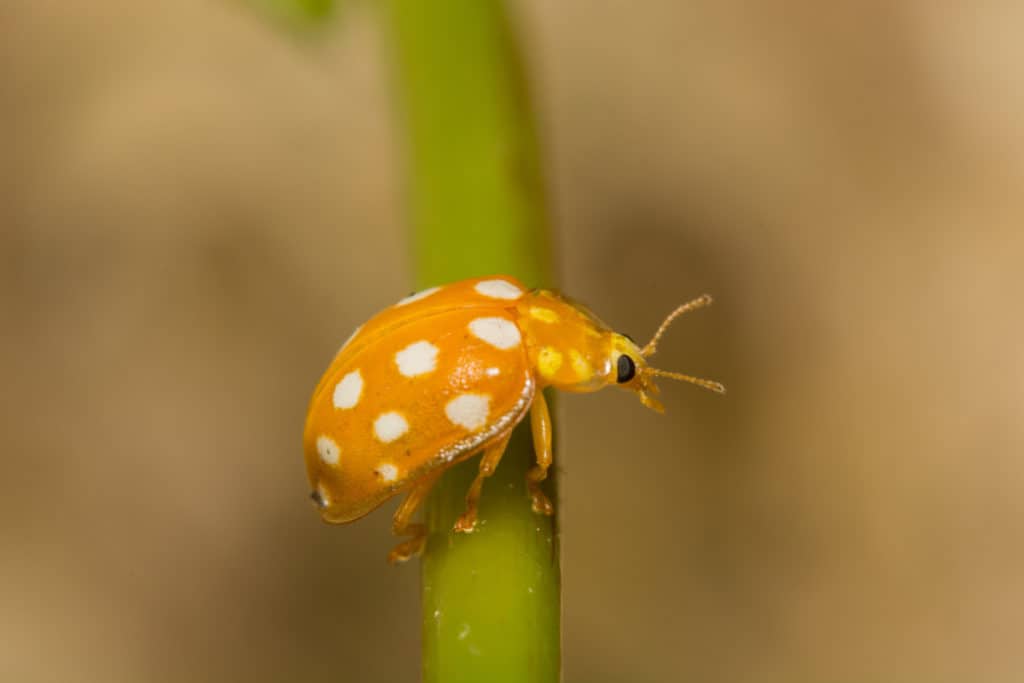
The Orange ladybug has fourteen to sixteen cream-colored spots. The bright orange of its shell manages to show through. The edges of the ladybug’s oval-shaped shell and head are slightly transparent.
The Mexican Bean Beetle, The Squash Beetle, And The Hadda Beetle
These ladybug species along with several others belong to the genus Epilachna. This group is often as “false ladybugs” and are categorized as pests.
However, all of these beetles belong in the Coccinellidae family, making them ladybugs or ladybirds.
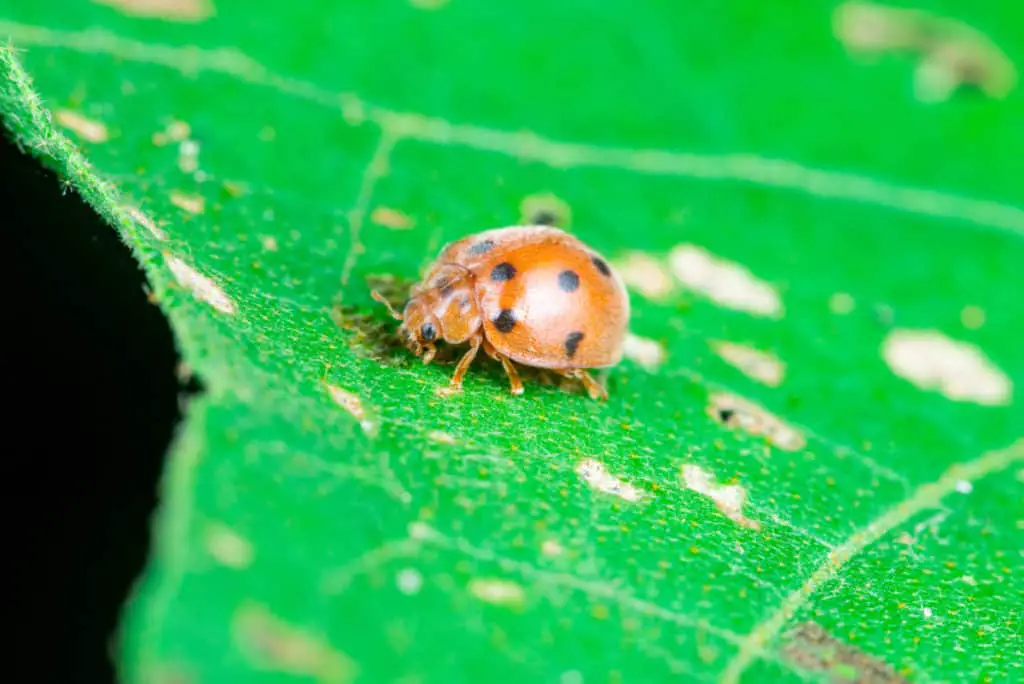
The Mexican bean beetle (Epilachna varivestis) is native to southern Mexico but can be found throughout the U.S. It has a pale orange shell with black spots.
The Squash beetle (Epilachna borealis) is widely distributed throughout the Eastern U.S. It is also orange with black spots.
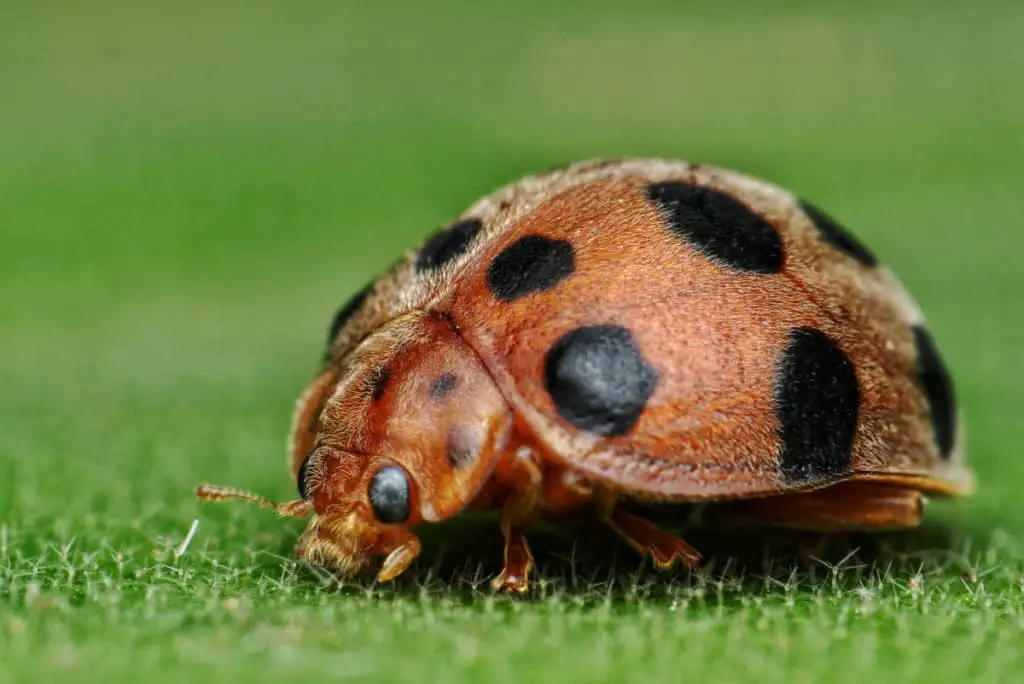
The Hadda beetle (Epilachna vigintioctopunctata) is from South East Asia and can be found throughout Australia and South America. It has a convex shell colored light orange with twenty-eight spots.
Dietary Preferences
These orange-colored ladybugs predominantly eat plants or fungus.
The Orange Ladybug’s primary food source is the mildew found on leaves, occasionally eating the leaves themselves, and rarely aphids.
The subfamily Epilachninae is defined by its dietary preference for plants. Unsurprisingly, each of these species is known for eating the plants they are named after; legumes, squash, and potatoes (for the Hadda beetle).
This is not to say that every orange ladybug you meet is a herbivore. As mentioned previously, the Multicolored Asian ladybug also comes in orange. It maintains an omnivorous diet.
Toxicity
Depending on the shade, orange is an effective signaling color, though it is not as contrasting as yellow or red. However, according to a study published in Nature, the Orange ladybug was the most toxic out of the five species they tested.
7. Yellow Ladybugs
Yellow is another popular color for ladybugs, there are hundreds of morphs as well as whole species that are colored yellow.
A few of the most strikingly yellow species are; the Twenty-two spotted ladybug, the Fungus-eating ladybug, and the Yellow ladybug.
The Twenty-two Spotted Ladybug
The twenty-two spotted ladybug, scientifically known as Psyllobora vigintiduopunctata. This ladybug can be found all over Europe.
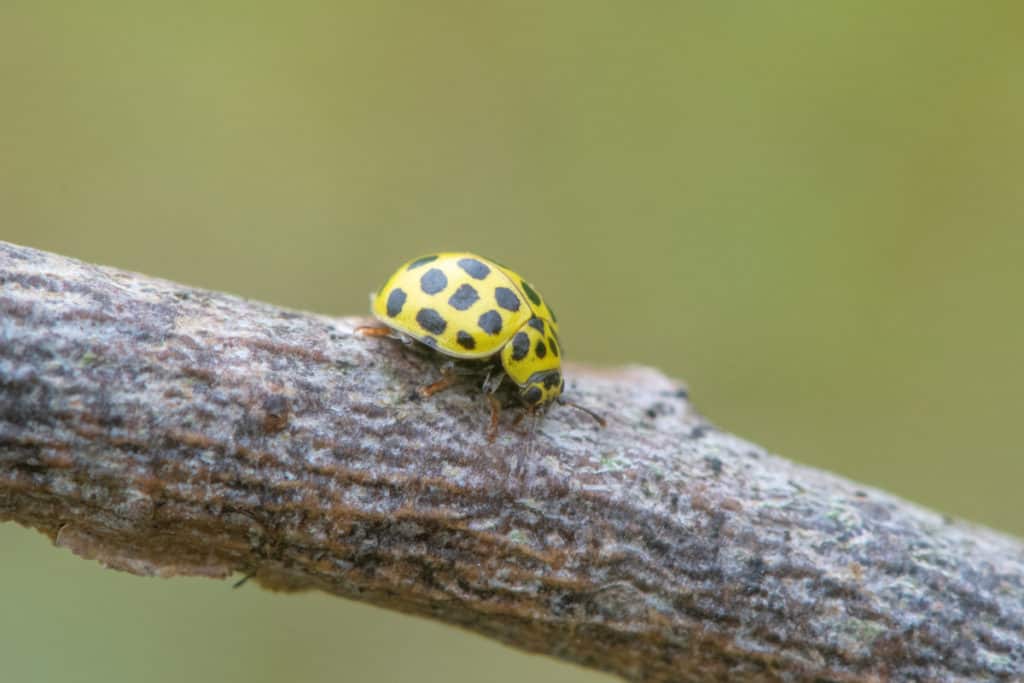
It is small in size and has twenty-two non-connecting black spots. Its shell is slightly oblong and bright yellow.
There is a second variation within this species. Its head is white instead of yellow.
The Fungus-eating Ladybug And The Yellow Ladybug
While both of these brightly colored species belong to the same genus Illeis and can be found throughout Asia and Oceana, only the Fungus-eating ladybug originated in Australia. The origin of the Yellow ladybug is unclear.
The Fungus-eating ladybug (Illeis galbula), is beautifully colored with a bright yellow shell and an inter-connected zig-zagging pattern of black spots.
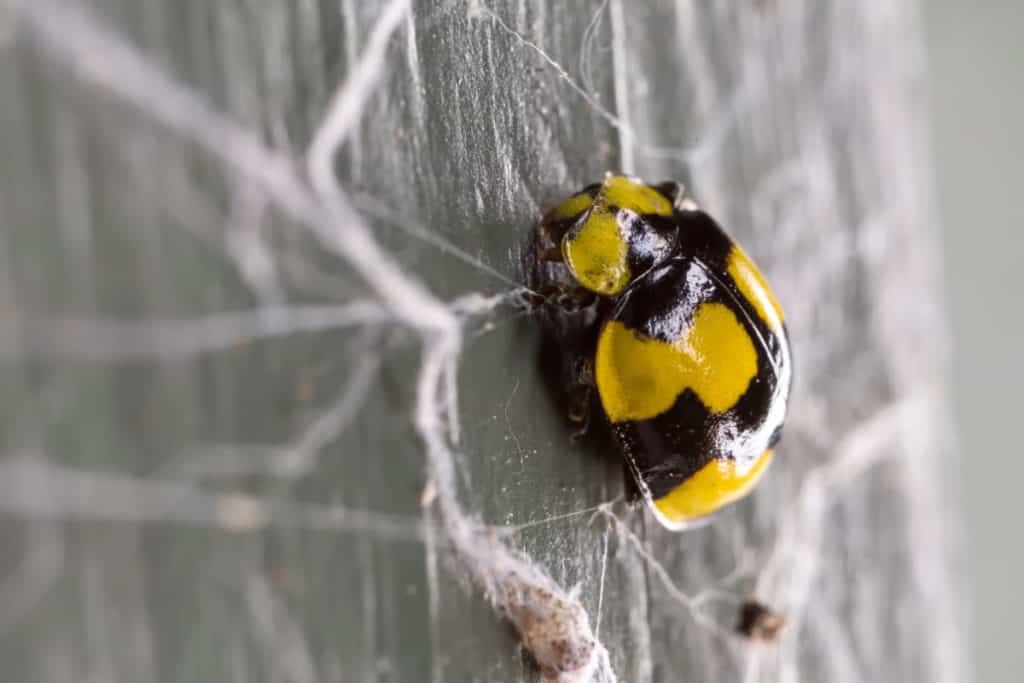
As its name indicates, the Yellow ladybug (Illeis koebelei), is a lemon-yellow color, with a white head, and no spots. Its shell is convex and oblong with a slightly transparent rim.
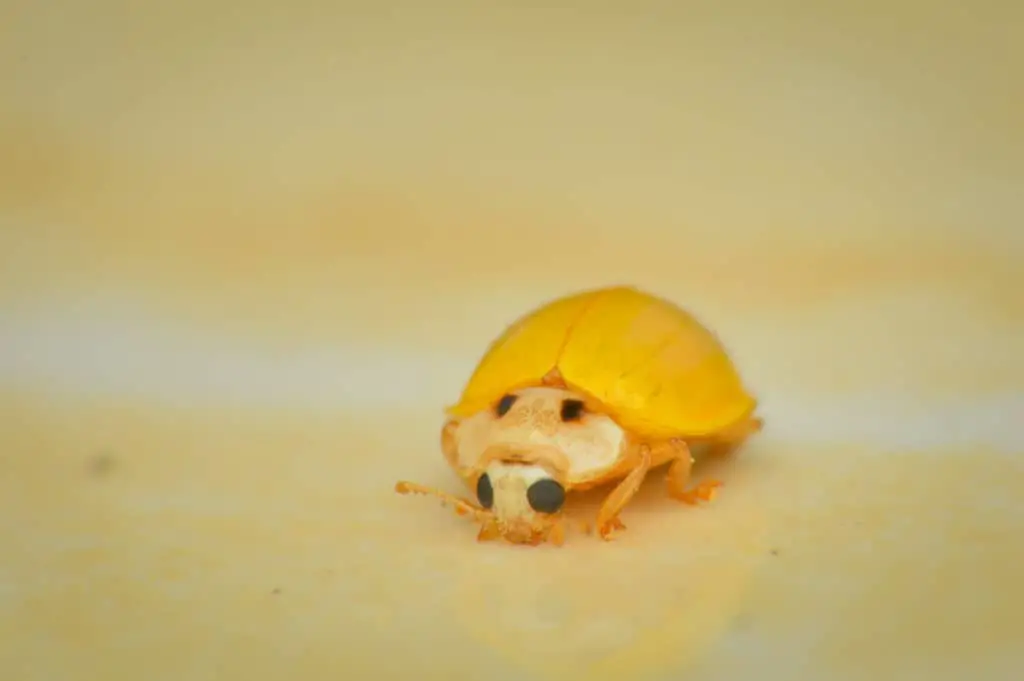
Dietary Preferences
All of these yellow ladybugs are primarily fungus eaters.
Both the Fungus-eating and the Yellow ladybug prefer to munch on powdery mildew, particularly the fungus spores. After making it through the winter, the Fungus-eating ladybug will also feed on pollen in the spring.
Though there are a lot of yellow ladybugs whose essential food is fungus and plants, there are plenty more that are predaceous.
Toxicity
Yellow ladybugs have a reputation for being poisonous pests that will invade homes and make pets sick. These comments are usually directed at the yellow variant of the Multicolored Asian ladybug.
However, according to a study in Nature, yellow may not indicate as high a toxicity level as one would expect. In the study, the Fourteen-spotted ladybug was only the fourth most toxic ladybug out of five.
While these ladybugs smell and taste bad, they are not poisonous to humans, and only rarely do they pose a threat to pets.
8. White/Grey/Beige Ladybugs
Though the idea of a white ladybug sounds like a fun photoshop project, there are several different species of white, grey, and beige ladybugs found in nature. For instance, the Fifteen-spotted ladybug, the Ashy grey ladybug, and the Twenty-spotted ladybug.
Fifteen-Spotted Ladybug
The Fifteen-spotted ladybug is also known as Anatis labiculata. It is native to North America and can be found throughout the continent.
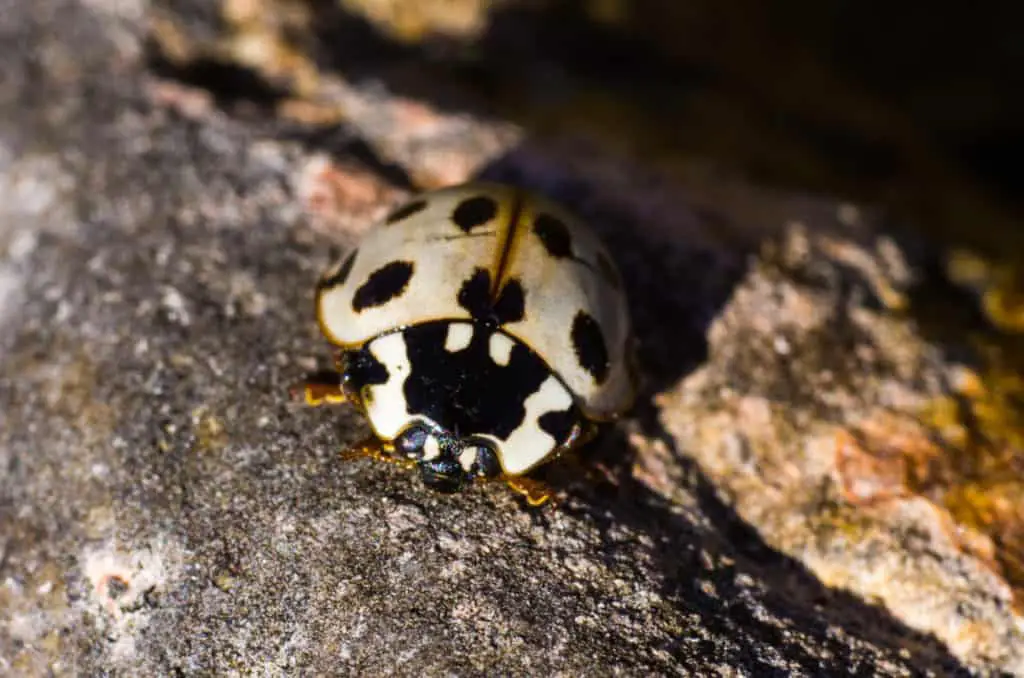
Apart from its unique coloring, the Fifteen-spotted ladybug looks exactly like commonly found red ladybugs. It has a round helmet-like shape and its shell is varying shades of white with black spots.
Interestingly, the Fifteen-spotted ladybug does not stay the same color. As the ladybug ages, its shell gets darker. Eventually, the dark shell blends into the spots, giving the ladybug a dark appearance in their old age.
Ash Grey Ladybug
Another white ladybug is the Ash grey ladybug. This ladybug’s official name is Olla v-nigrum, and can be found throughout North America. There have been sightings of it as far as Argentina and France.
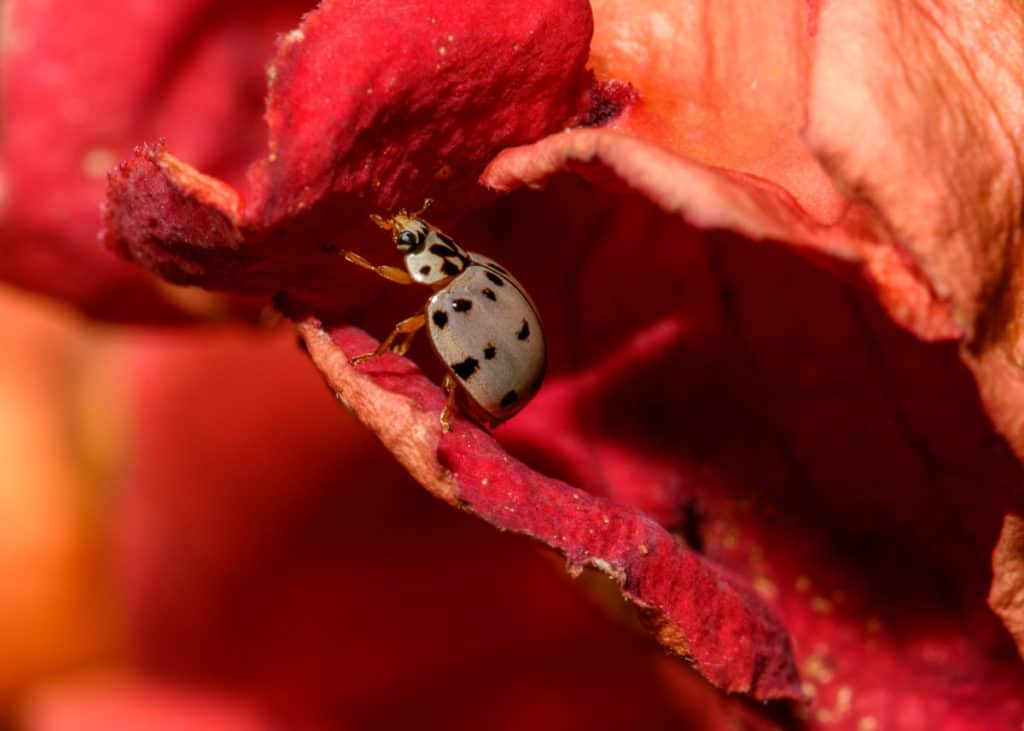
Though its name is the Ash grey ladybug, being polymorphic, not all of these creatures are ash grey. Most of them are varying shades of blue-grey or a mottled beige-white color with black spots.
There is another variation of the Ash grey ladybug that is all black with two trapezoidal-shaped red spots.
Twenty-Spotted Ladybug
The rarest of the white ladybugs is the Twenty-spotted ladybug. This shy creature’s scientific name is Psyllobora vigintimaculata and like its fellow white ladybugs, it is native to North America.
Its shell’s coloring is a mottled creamy white. Its twenty black-brown spots are splotchy and interconnected, with no consistent pattern.
The most notable thing about the Twenty-spotted ladybug’s appearance is that it is only 1/16 of an inch. Earning it the name “Wee-tiny ladybug”.
Dietary Preference
These ladybugs are a mix of predacious and fungus eating.
The Twenty-spotted ladybug predominantly eats powdery mildew spores and conidia.
Like most ladybugs, the Fifteen spotted and the Ash grey ladybug’s diet is primarily carnivorous. They eat the eggs and larvae of beetles, moths, butterflies, and bees along with a few aphids species.
Toxicity
There is no clear information on white ladybug toxicity. Given the muted colors of these ladybugs, it seems likely that they have low levels of toxicity.
Misconceptions About Ladybug Colors.
The variety of ladybugs in existence makes it easy to confuse other insects for ladybugs or believe that photoshopped variations of the creature are real.
Purple Ladybug – There has been a lot of fuss online over these very pretty ladybugs. The story being, an article was posted on Facebook about purple ladybugs found only in Hawaii. Unfortunately, the internet is not always the most reliable source for scientific evidence and the story was fake. There are no scientific records of purple ladybugs.
The only real contender for the title of purple ladybug is the Fifteen-spotted ladybug. As this ladybug ages, its shell gets darker. If the ladybug gets old enough, its shell will turn a dark reddish-purple color.
Green Ladybug – What is often mistaken for a green ladybug is none other than the cucumber beetle. It is an easy mistake given the beetles’ characteristic spots. Spotted or not these little creatures belong to the Chrysomelidae family and are not ladybugs.
That said, several “black” ladybugs have shiny reflective shells. Though they are black, they are glints of several other colors, similar to a puddle of oil. These colors are most commonly green and blue.
The Wrap Up
This guide went through all of the recognized colors of ladybugs. However, it only began to touch on the incredible diversity within ladybugs. There are hundreds of other color and pattern variations that were not mentioned.
While this guide is not a scientific study, it demonstrated a few generalizations regarding diet and toxicity concerning color.
As for diet, while there are many exceptions, orange, yellow, white, or beige-colored ladybugs may have plants or fungus as their essential food source. If the ladybug is black, red, or brown it is likely to be predacious.
For toxicity, the general rule about conspicuous colors still applies. The more saturated and contrasting a ladybug is, the more toxic it is likely to be.
While you might be disappointed that there is not a ladybug for every color of skittle. Just remember, ladybugs are still evolving and researchers are still discovering them. We have not seen all that there is to see.
Sources
https://uwm.edu/field-station/seven-spotted-ladybug/
https://www.nature.com/articles/249179a0
https://www.jstor.org/stable/2389297
https://www.ento.csiro.au/biology/ladybirds/lucid/key/lucidKey/Media/Html/orcusBilunulatus1.htm
https://www.ento.csiro.au/biology/ladybirds/lucid/key/lucidKey/Media/Html/orcus1.htm#description
